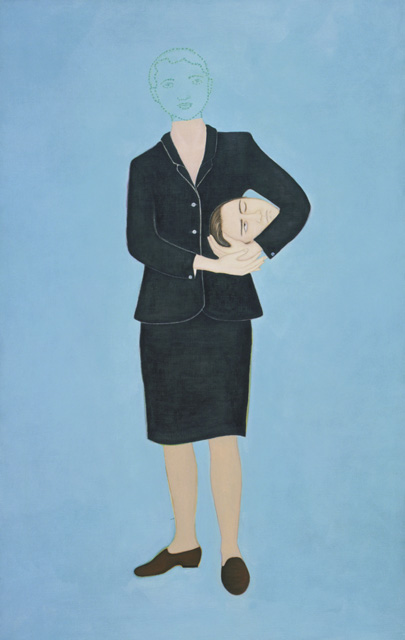


Brevity, we are told, is the soul of wit, and of all artforms, cartoons are the most concise form of storytelling. In a few quick lines, the cartoonist is able to conjure whole worlds, drawing on cultural mores and assumptions to send little arrows that prick at the absurdities and dilemmas of our everyday lives. The best cartoons are animated by an economy of line and a spirit of jest—comic takes on a chaotic world.
Vivienne Shark LeWitt's paintings of the 1980s drew strongly on traditions of fable and romance, symbolic narratives closer to the workings of medieval allegory than, for example, the modern-day ellipses of cinema. She has had a longstanding interest in book covers, film posters, and book illustrations—images freighted with a duty of meaning. Her paintings of the last decade have been likened to cartoons from the magazine The New Yorker—sharp vignettes from modern life and human nature. Her work is, she has explained, about 'how people get on with each other, or don't get on'.1 This is the material of the novel and the sit-com, the mise en scène of the comedy of manners.
Bloody hell (1994) is a fine example of Shark LeWitt's cartoon genre paintings. The silhouetted head conjures cut-out paper doll albums, except in this case what is changeable is not clothes but the doll's head. As the artist has written, 'The dotted line face could be read as being the "inner" self, or maybe it could be a constructed self that replaces the "real" self. The obvious discrepancy between it and the "real" head would seem to suggest a conflicted sense of self or self-image'.2 The pacific background in which the figure floats is at odds with the implied violence of the pose. It is a cryptic image, a joke without a punchline.
The uniform of the executive woman is a familiar trope in the business pages of our newspapers: short hair, a bespoke suit, usually spectacles. Like the ancient figure of the female warrior, the modern-day corporate woman encapsulates many of the paradoxes at the heart of the notion of equality between the sexes. Are women who fit into patriarchal structures resistance fighters, or little more than men in skirts, men manqué? Is this painting about the opposition of the sexes, or perhaps the opposition within women of sexual or gendered roles?
Decapitation has a rich mythic history, most notably in the apocryphal Biblical story of Judith and Holofernes. Artemisia Gentileschi's unflinching depiction of this subject, in which Judith is portrayed as a cold-blooded executioner, is arguably the most famous painting in history by a woman. The popularity of this subject for Renaissance and Mannerist artists is puzzling to a contemporary sensibility, particularly the way in which Judith's moral qualities—of strength and beauty—were considered the principal subject of the painting, not, as to our eyes, a gruesome assassination. We might consider Shark LeWitt's Bloody hell a twentieth-century rendition of this tale: its cuteness, like its two-dimensionality, belying its not so covert aggression.
- Hannah Fink
Vivienne Shark LeWitt is represented in Australia by Anna Schwartz Gallery, Melbourne and Sydney and Roslyn Oxley9 Gallery , Sydney.